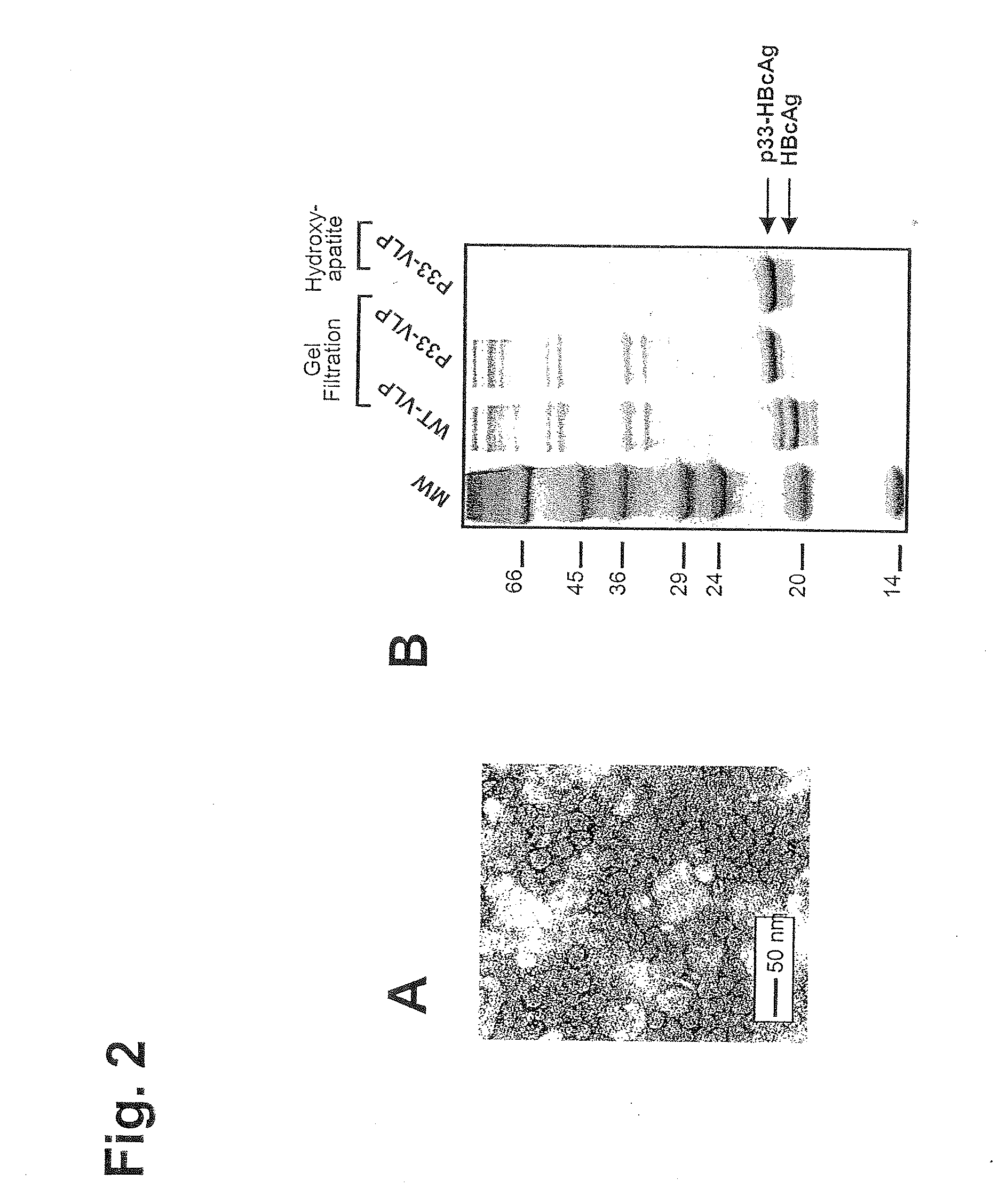In Vivo Activation of Antigen Presenting Cells for Enhancement of Immune Responses Induced by Virus Like Particles
a technology of antigen presenting cells and immune responses, applied in the field of vaccines, immunology, virology and medicine, can solve the problems of insufficient administration of purified proteins alone, unrecognized mechanisms of this help, etc., and achieve the effect of increasing t cell responses and enhancing expression of costimulatory molecules or cytokines
- Summary
- Abstract
- Description
- Claims
- Application Information
AI Technical Summary
Benefits of technology
Problems solved by technology
Method used
Image
Examples
example 1
Generation of p33-VLPs
[0322]The DNA sequence of HBcAg containing peptide p33 from LCMV is given in FIG. 1. The p33-VLPs were generated as follows: Hepatitis B clone pEco63 containing the complete viral genome of Hepatitis B virus was purchased from ATCC. The gene encoding HBcAg was introduced into the EcoRI / HindIII restriction sites of expression vector pkk223.3 (Pharmacia) under the control of a strong tac promoter. The p33 peptide (KAVYNFATM) derived from lymphocytic choriomeningitis virus (LCMV) was fused to the C-terminus of HBcAg (1-183) via a three leucine-linker by standard PCR methods. A clone of E. coli K802 selected for good expression was transfected with the plasmid, and cells were grown and resuspended in 5 ml lysis buffer (10 mM Na2HPO4, 30 mM NaCl, 10 mM EDTA, 0.25% Tween-20, pH 7.0). 200 μl of lysozyme solution (20 mg / ml) was added. After sonication, 4 μl Benzonase and 10 mM MgCl2 was added and the suspension was incubation for 30 minutes at RT, centrifuged for 15 mi...
example 2
P33-VLPs are Efficiently Processed by DCs and Macrophages
[0323]DCs were isolated from lymphoid organs as described (Ruedl, C., et al., Eur. J. Immunol. 26:1801 (1996)). Briefly, organs were collected and digested twice for 30 min at 37° C. in IMDM supplemented with 5% FCS and 100 μg / ml Collagenase D (Boehringer Mannheim, Mannheim, Germany). Released cells were recovered and resuspended in an Optiprep-gradient (Nycomed, Norway) and centrifuged at 600×g for 15 min. Low-density cells in the interfase were collected and stained with an anti-CD11c antibody. DCs were purified by sorting with a FACSStarplus (Becton Dickinson, Mountain view, Calif.) on the basis of CD11c expression and excluding propidium iodide positive cells. Purified DCs, B and T cells (FIG. 3) obtained from spleens and thioglycollate-stimulated peritoneal macrophages (FIG. 4) were pulsed for 1 h with various concentrations of p33-VL, VLP (1-0.01 μg / ml) or the peptide p33 (10-0.100 ng / ml). After three washings, presenter...
example 3
P33-VLPs Injected with Anti-CD40 Antibodies Induce Enhanced CTL Activity
[0324]Mice were primed with 100 μg of p33-VLPs alone, injected subcutaneously, or together with 100 μg of anti-CD40 antibodies, injected intravenously. Spleens were removed 10 days later and restimulated in vitro for 5 days with p33 pulsed splenocytes. Lytic activity of CTLs was tested in a 51Cr release assay essentially as described (Bachmann, M. F., “Evaluation of lymphocytic choriomeningitis virus-specific cytotoxic T cell responses,” in Immunology Methods Manual, Lefkowitz, I., ed., Academic Press Ltd, New York, N.Y. (1997) p. 1921) using peptide p33 (derived from the LCMV glycoprotein, aa33-42) labeled EL-4 cells as target cells. Briefly, EL-4 target cells were pulsed with peptide p33 (KAVYNFATM, aa33-42 derived from the LCMV glycoprotein) at a concentration of 10−7 M for 90 min at 37° C. in the presence of [51Cr]sodium chromate in IMDM supplemented with 10% FCS. Restimulated splenocytes were serially dilut...
PUM
| Property | Measurement | Unit |
|---|---|---|
| diameter | aaaaa | aaaaa |
| pH | aaaaa | aaaaa |
| concentrations | aaaaa | aaaaa |
Abstract
Description
Claims
Application Information
 Login to View More
Login to View More - R&D
- Intellectual Property
- Life Sciences
- Materials
- Tech Scout
- Unparalleled Data Quality
- Higher Quality Content
- 60% Fewer Hallucinations
Browse by: Latest US Patents, China's latest patents, Technical Efficacy Thesaurus, Application Domain, Technology Topic, Popular Technical Reports.
© 2025 PatSnap. All rights reserved.Legal|Privacy policy|Modern Slavery Act Transparency Statement|Sitemap|About US| Contact US: help@patsnap.com



